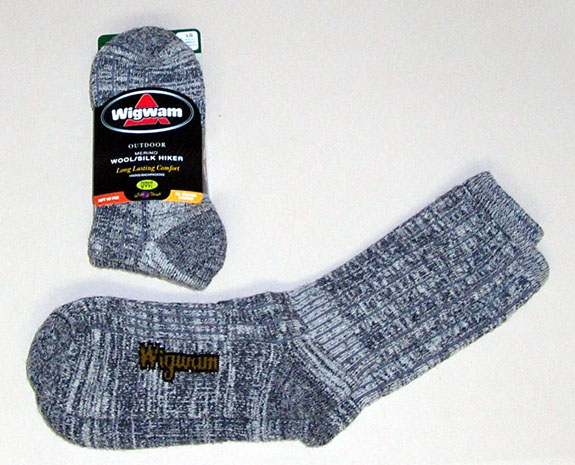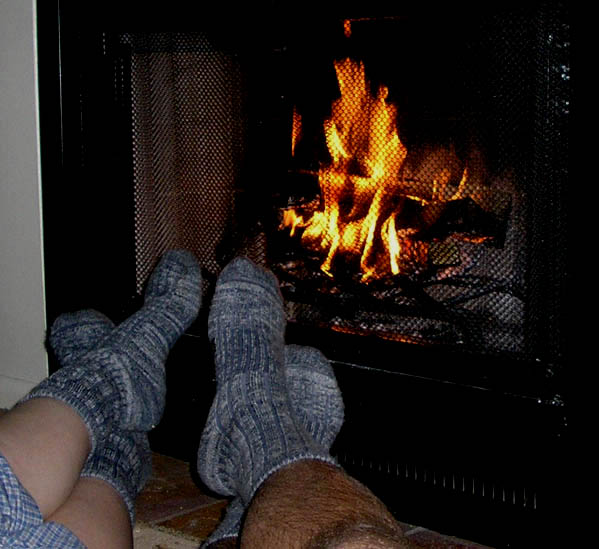|
WIGWAM WOOL/SOLK HIKERS
TEST SERIES BY RAYMOND ESTRELLA
LONG-TERM REPORT
March 14, 2007
CLICK HERE TO SKIP TO THE FIELD REPORT
CLICK HERE TO SKIP TO THE LONG-TERM REPORT
TESTER INFORMATION
|
NAME:
|
Raymond Estrella
|
|
EMAIL:
|
rayestrella@hotmail.com
|
|
AGE:
|
46
|
|
LOCATION:
|
Huntington Beach California USA
|
|
GENDER:
|
M
|
|
HEIGHT:
|
6' 3" (1.91 m)
|
|
WEIGHT:
|
205 lb (93.00 kg)
|
I have been backpacking for over 30 years, all over the state of California, and also in Washington, Minnesota, Nevada, Arizona, Idaho and Utah. I hike year-round, mostly in the Sierra Nevada, and average 500+ miles (800+ km) per year. As I start my 4th decade of backpacking I am making the move to lightweight gear, and smaller volume packs. I start early and hike hard so as to enjoy the afternoons exploring. I usually take a freestanding tent and enjoy hot meals at night. If not hiking solo I am usually with my brother-in-law Dave or fiancée Jenn.
INITIAL REPORT
The Product
Manufacturer: Wigwam Mills Inc.
Web site: www.wigwam.com
Product: Merino Wool/Silk Hiker
Item number: F2337
Year manufactured: 2006
MSRP: N/A
Size tested: Large
Other sizes available: Small, Medium and Extra Large depending on color
Color tested: Grey (Also available in Charcoal, Navy and Olive Heather)
Weight, pair (measured): 3.8 oz (108 g)
Warranty (from hang tag): "If you are not completely satisfied with your Wigwam socks, we guarantee to replace them for up to one year from the date of purchase."

Product Description
The Wigwam Wool/Silk Hiker (hereafter called the Wigwam or sock) is a multi-fiber blend sock aimed at the hiking and backpacking crowd. It is constructed of 65% Merino wool, 20% nylon, 10% silk and 5% Spandex.
I received two pairs of them. They came in the retail packaging which has a wealth of information printed on it in four languages. The back has the materials list, a sizing chart, a list of comfort features and some marketing hyperbole. The side contains the warranty information, while the inside has laundering instructions. I found it interesting that these differ from so many others of my hiking socks. They are as follows; turn inside-out, machine wash warm, fabric softener recommended, dry on low.
The socks feels very smooth to the touch. I have many pairs of merino wool socks from Wigwam and these feel softer than the ones in the drawer. I will have to attribute that to the addition of the silk and nylon. They are what I would describe as medium-weight. This is the weight range that most of my socks are.
Although the color is listed as gray, the socks are actually made with yarns that are a mix of gray and natural (white-ish) colors. The result is the speckled look seen in the picture above. (My girlfriend says that it should be referred to as Salt & Pepper. But weren't they the big bummed rapper girls?)
The 9 in (23 cm) high leg of the socks are woven with a "mock rib fillet stitch" that resembles the true rib patterns of the wool socks of yesteryear. Where as those were actual ribs of yarn connected together, the mock rib look is done by thinning the stitch/loop count in between the "ribs." This pattern is used on the instep as well.
At the top is a 1 in (2.5 cm) band that they call an "extra-stretch Morpul top." It seems to have some pretty decent elastic inside of it. At the toe they say that it has an "ultra-smooth Lin-toe closure". I will agree heartily. This may be the flattest toe seam I have ever seen. The seam is not only flat on the outer surface of the sock, but it is indented when viewing from the inside.
They have reinforced heels. The loop-count seems to be quadrupled in the heel to give some added cushioning and to help with wear. To see an even higher loop-count I just look at the "elasticized arch panel." This area is very dense and cushioned.
The Wigwam name is on the bottom of the socks, and for the life of me I can not figure out how they did it. I see the black outline on the inside of the sock, but no black in between the letters and no yellow threads. But it does not feel like it is sprayed on as the weave opens when I pull it.
I am pretty impressed right off with these socks. They feel great. I am going to take them on a two day backpacking trip tomorrow. The company touts the wicking ability of them, and I will try them alone, and with my normal X-Static liner socks.
FIELD REPORT
Field Conditions
Minnesota November: Buffalo State Park: 34 F (1 C), winds 18 mph (29 kmh) Maplewood State Park 19 F (-7 C), Itasca State Park 24 F (-4 C). All of the trails in Minnesota tend to be packed dirt (or snow covered) in hardwood forests. Itasca has some pine trees in the mix. I wore some new Lowa Vertex GTX hiking boots on these and the Utah hikes
California December: 20-mile (32 km) dayhike with about 1500' (460 m) of gain. Three days later was a 26.2-mile (42 km) one day climb of Mount San Jacinto (11499'/3505 m) with 5000' (1524 m) of gain. I wore boots for both of these hikes. I also used them for an icy, snowy 18-mile (29 km) trip into the San Jacinto Wilderness and State Park. I wore boots with them on this trip.
I used the Wigwams in the Wasatch Mountains of Utah for one week in December. The temperatures there ranged from 5 to 28 F (-15 to -2 C). There was about 3 ft (1 m) of snow, with some fresh powder a couple of the days.
Observations
The Wool/Silk Hikers have proven to be some of the most comfortable socks I have ever worn. They feel so soft and, well, silky, that I feel that they should be less durable than my other socks. But that is not proving to be the case.
I have been wearing them almost daily in Minnesota and Utah. (I spent a total of six weeks there in November and December.) They have worked quite well to keep my feet warm in boots on snow, and frozen ground. I find myself wearing them around the house without shoes as a comfortable slipper replacement.
While snowshoeing and hiking in the states above I have used them about 40% of the time without liner socks, and the rest of the time with some. I have not noticed much difference. The socks sans liners did seem to keep my foot a bit wetter than with the liners, but they do an admirable job of wicking on their own.
My California experiences with them are a different story.
In early December I did a hard, fast solo dayhike of 20+ miles (32 km) without liner socks. I was wearing boots that I have put a few hundred miles (480+ km) on this year without a single blister. In 5.5 hours of hiking I got a doozy of a blister on the back of my right heel, off-center, which is a place I have never got one before.
Three days later we did a 9.2-hour, 26-miler (42 km) with a lot of climbing. I wore my X-Static liners with the same boots and had no problems. I have decided to wear the liners with the Hikers for the most part.
I have been following the washing instructions and love not having to worry about taking them out of the other clothes before throwing everything in the dryer. They have not shrunk that I can tell and are still devoid of loose threads or pilling. I have been putting them in with all of my other laundry in true guy fashion. They have been washed in excess of ten times each at this point. Here is a picture drying them without the use of a dryer…

This concludes the first two months of use. The following reflects the final two months of extended testing.
LONG-TERM REPORT
Field Conditions
I have worn the Wool/Silk Hikers in California, Utah and Minnesota again during the last two months of the test. They have probably seen 12 days in the field. The lowest temps were in Minnesota where it was -20 F (-29 C). All locations have been on snow and/or ice, in hiking boots with snowshoes or crampons on. Elevations have reached 11500 ft (3500 m).
They have also been worn as a daily use sock in Minnesota with a pair of pac-boots. This has added another 10 days of use. A liner sock was worn with them for all hiking use, while they were worn sans liner with the pac-boots.
Observations
The Wool/Silk Hikers have continued to impress me for the past two months. They have held up very well. I wash them after every use and have been drying them in the dryer. They are still in great shape, with no shrinking noticed. They are still very comfortable too. They have not compacted the fibers that I notice, they are still very soft to the touch. The cushioning effect of the fibers is just as prominent as the day I received them.
I have not experienced any more blisters while wearing them, even on an 18 mile (29 km) hard cranking day-hike up the Devil's Slide Trail on snow and ice, where I get a lot of extra friction from the lousy footing.
One of my concerns going into this test was whether the blended fibers would hold up. I have had wool/synthetic blend socks that lasted only a few weeks before they got holes. My experience has been that they fail faster than just a straight wool sock. These are actually looking better than all-wool socks that I have with the same amount of use racked up on them.
I have found nothing to complain about these socks other than the fact that I only have two pairs of them. I guess a trip to REI (my favorite gear store) will rectify that problem.
I would like to thank Wigwam Mills and BackpackGearTest.org for the opportunity to test these great socks.
This report was created with the BackpackGearTest.org Report Writer Version 1.
Copyright 2007. All rights reserved.
Read more reviews of Wigwam gear
Read more gear reviews by Ray Estrella
|




